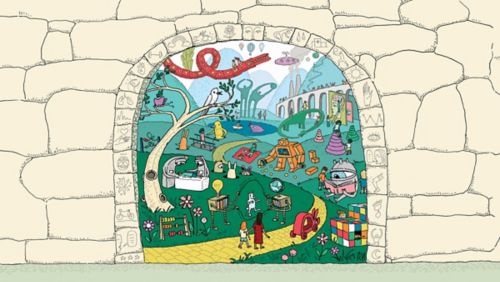St. Jude Family of Websites
Explore our cutting edge research, world-class patient care, career opportunities and more.
St. Jude Children's Research Hospital Home

- Fundraising
St. Jude Family of Websites
Explore our cutting edge research, world-class patient care, career opportunities and more.
St. Jude Children's Research Hospital Home

- Fundraising
Identifying risks and restrictions: Rehabilitation and cancer survivorship

Rehabilitation and cancer survivorship take into account not only the effects of the cancer and treatment, but also long-term functional restrictions. In a first for the field, Kristin Lyons, director of Rehabilitation Services, and Jessica Sparrow, lead occupational therapist, collaborated with a team of oncology rehabilitation clinicians to provide a comprehensive overview of rehabilitation for children with cancer.
Kristin Lyons, director of Rehabilitation Services, and Jessica Sparrow, lead occupational therapist, worked as part of a team of oncology rehabilitation providers from pediatric institutions across the country to co-author a recent Seminars in Oncology Nursing article, which provides a comprehensive overview of rehabilitation screening, assessment, and intervention for children with cancer.
The article is a first for the field, creating a resource for multidisciplinary pediatric oncology care teams and rehabilitation staff working with children with cancer. Children with cancer are at risk for certain restrictions in function and many can benefit from rehabilitation services. Sparrow and Lyons recommend evidence-based screenings medical staff can use to identify rehabilitation needs in childhood cancer patients, as well as in-depth assessments and interventions for rehabilitation professionals with or without pediatric oncology experience.
Sparrow and Lyons answered a few questions about working with cancer patients and how they tailor rehabilitation for each patient.
Question: Describe rehabilitation’s role in cancer treatment – what sorts of things are you doing and looking for during patient treatment vs. post-treatment?
Answer: Children with cancer are at risk for experiencing cancer-related restrictions in their ability to participate in meaningful and age-appropriate activities. Barriers to participation can arise during cancer treatment or long after treatment has been completed. Certain types of cancers or treatments place children at risk for limitations in function, which guides our rehabilitation screening and monitoring of children with cancer. A child undergoing treatment may experience illness, weakness or other loss of function that limit their ability to play or participate in daily activities. Limitations that impact a child’s participation after treatment is complete are called ‘late effects.’ The rehabilitation team identifies barriers and works with the child and family to help overcome them. We use a top-down approach, which means we begin first by looking at activity limitations and participation restrictions, regardless of the type of cancer or treatment type. Then we identify what the barriers are and develop an intervention plan.
Q: What do you predict the goal of rehabilitation will be in 20 years?
A: As the number of pediatric cancer survivors grows so too does the focus of the entire oncology care team on their long-term wellness and quality of life. The field of pediatric oncology rehabilitation is gaining significant traction. Increased awareness of the value and role of rehabilitation will mean more children receive rehabilitation as the standard in oncology care, including an even greater focus on the prevention of functional impairments. Predicting the risk for functional limitations in certain populations of children with cancer will open opportunities for a preventative rehabilitative approach to focus more so on minimizing functional deficits before they ever emerge. Whatever oncology treatment looks like in 20 years, if there are children who experience participation limitations because of cancer and treatment, rehabilitation providers will be there to help guide them back to being able to do what they love to do.
Q: Is there a hierarchy of needs for rehab? If so, what would that be?
A: The patient’s diagnosis and treatment modalities give us an idea of what we need to do. In addition, the tumor itself, surgery, and treatments can impact functioning for patients. For example, a brain tumor patient may have swallowing deficits due to tumor location, mobility problems after surgery or hearing loss from chemotherapy. When we first meet a patient, our priority is to learn about their current level of functioning, determine areas needing improvement or barriers to participation in meaningful activities, and discuss the patient’s and family’s goals. We help to guide, structure, and recommend goals, but ultimately, the priorities of the family and child guide the rehabilitation process. Goals that are motivating to the patient are likely to be the most effective.
Here are some examples of the most basic goal for each discipline
• Occupational therapy – ability to participate in daily activities, such as dressing, grooming, and self-feeding ., and activities that require fine motor skills (for example a– child’s ability to write, and pick up a cheerio with a pincer grasp or a young adult's ability to independently button a shirt)
• Speech-language pathology – ability to communicate wants and needs effectively, safely eat and drink by mouth, participate in social activities and support educational performance
• Physical therapy – the ability to navigate the environment safely (e.g., crawling, walking, using stairs/wheelchair/walker safely, etc.) and activities that require gross motor skills (jumping, skipping, bending down, riding a bike, etc.).
Q: How important is communication between rehab and clinical fields?
A: Though each rehabilitation discipline has its own objectives for patients, these goals may be intertwined. We frequently collaborate to better care for our patients. For example, a patient who has swallowing and fine motor difficulty benefits from collaboration between a speech-language pathologist and an occupational therapist. The speech-language pathologist can work to improve the ability to accept food into the mouth, prepare the food to be swallowed by chewing thoroughly and swallowing the food safely. The OT can help the patient to reach for and hold feeding utensils and bring food or drink to the mouth. In addition to documenting in the medical record, rehabilitation professionals work closely with care team members to discuss patient performance, progress, and interdisciplinary needs.
Q: Is rehabilitation work with survivors different than that of rehabilitation of a stroke victim or physical injury recovery?
A: When you think about a typical course of rehabilitation such as that for an individual who has experienced a stroke, you would expect a trajectory of some level of continued improvement after the injury. However, for a child with cancer, there are many ups and downs in functional abilities throughout rehabilitation. Hospital stays, treatment side effects and illness among other issues can occur at any time during the cancer treatment continuum and cause fluctuations in functional abilities. Because children may have ups and downs in function during and after cancer treatment, rehabilitation professions meet the child where they are and tailor the child’s goals to that stage in their care.






